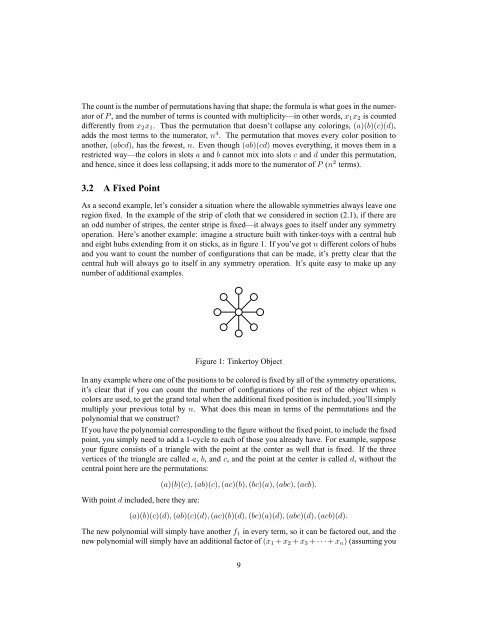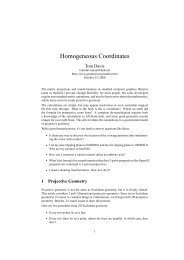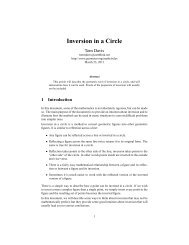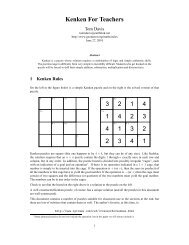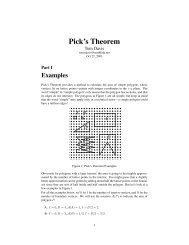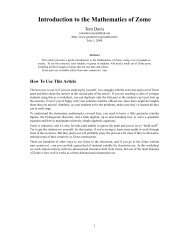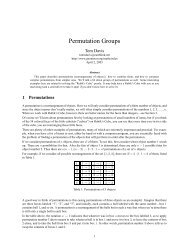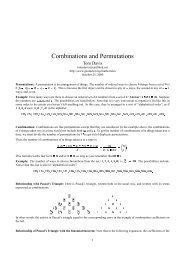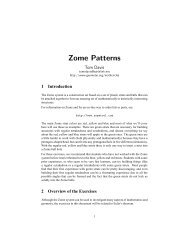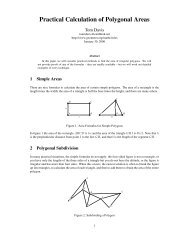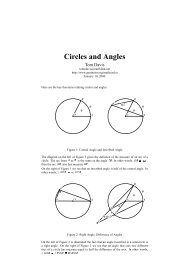P´olya's Counting Theory - Home Page -- Tom Davis
P´olya's Counting Theory - Home Page -- Tom Davis
P´olya's Counting Theory - Home Page -- Tom Davis
You also want an ePaper? Increase the reach of your titles
YUMPU automatically turns print PDFs into web optimized ePapers that Google loves.
The count is the number of permutations having that shape; the formula is what goes in the numerator<br />
of P , and the number of terms is counted with multiplicity—in other words, x 1 x 2 is counted<br />
differently from x 2 x 1 . Thus the permutation that doesn’t collapse any colorings, (a)(b)(c)(d),<br />
adds the most terms to the numerator, n 4 . The permutation that moves every color position to<br />
another, (abcd), has the fewest, n. Even though (ab)(cd) moves everything, it moves them in a<br />
restricted way—the colors in slots a and b cannot mix into slots c and d under this permutation,<br />
and hence, since it does less collapsing, it adds more to the numerator of P (n 2 terms).<br />
3.2 A Fixed Point<br />
As a second example, let’s consider a situation where the allowable symmetries always leave one<br />
region fixed. In the example of the strip of cloth that we considered in section (2.1), if there are<br />
an odd number of stripes, the center stripe is fixed—it always goes to itself under any symmetry<br />
operation. Here’s another example: imagine a structure built with tinker-toys with a central hub<br />
and eight hubs extending from it on sticks, as in figure 1. If you’ve got n different colors of hubs<br />
and you want to count the number of configurations that can be made, it’s pretty clear that the<br />
central hub will always go to itself in any symmetry operation. It’s quite easy to make up any<br />
number of additional examples.<br />
Figure 1: Tinkertoy Object<br />
In any example where one of the positions to be colored is fixed by all of the symmetry operations,<br />
it’s clear that if you can count the number of configurations of the rest of the object when n<br />
colors are used, to get the grand total when the additional fixed position is included, you’ll simply<br />
multiply your previous total by n. What does this mean in terms of the permutations and the<br />
polynomial that we construct?<br />
If you have the polynomial corresponding to the figure without the fixed point, to include the fixed<br />
point, you simply need to add a 1-cycle to each of those you already have. For example, suppose<br />
your figure consists of a triangle with the point at the center as well that is fixed. If the three<br />
vertices of the triangle are called a, b, and c, and the point at the center is called d, without the<br />
central point here are the permutations:<br />
With point d included, here they are:<br />
(a)(b)(c), (ab)(c), (ac)(b), (bc)(a), (abc), (acb).<br />
(a)(b)(c)(d), (ab)(c)(d), (ac)(b)(d), (bc)(a)(d), (abc)(d), (acb)(d).<br />
The new polynomial will simply have another f 1 in every term, so it can be factored out, and the<br />
new polynomial will simply have an additional factor of (x 1 +x 2 +x 3 + · · ·+x n ) (assuming you<br />
9


